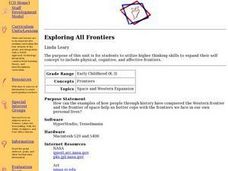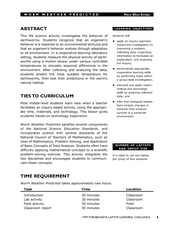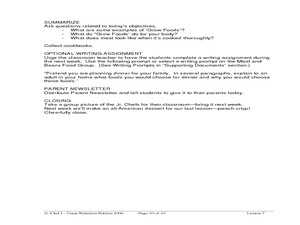Teach Engineering
What Does Light See?
The second installment of a seven-part series focuses on the refraction of light and how it affects the colors we see. Learners consider how this concept connects to biosensors for cancer detection.
Teach Engineering
Exploring Energy: Kinetic and Potential
The potential of the energy in the class is moving. The third segment in a six-part unit on energy provides a deeper understanding of kinetic and potential energy. Learners understand the relationship between mass, speed, and energy and...
Open Colleges
Your Brain Map: Strategies for Accelerated Learning
The brain is a complex organ with many different structures and functions. An interactive diagram allows learners to explore the different structures while pop-ups describe their functions. Secondary interactives show the structures of...
Curated OER
Vocabulary Practice with Present Tense Verbs
Learners determine the meaning of vocabulary in each of eight sentences and select from three possible sentences that have the same meaning expressed differently. A rigorous way to practice vocabulary; more thought is needed than if you...
Teach Engineering
Off-Road Wheelchair Challenge
Challenge your class to use their understanding of the engineering design process to design and build a small-scale, off-road prototype for an assistive technology device. Teams select materials to build their scale models, and, using...
Teach Engineering
Microbes Know How to Work!
Scholars harness the power of microbes with an engaging activity that uses yeast to break down sugar in water. Multiple setups of the same experiment lets learners determine which temperature results in the fastest rate of sugar...
Teach Engineering
Maximum Mentos Fountain
A messy fountain is potentially an energy experiment in disguise. Groups investigate the variables in creating a fountain from soda and Mentos. The last activity in a six-part series on energy has the class observe the fountain in terms...
Curated OER
Energy Dreams by Design
Students explore a new home and design some of its electrical features. They construct a model of the electrical features and consider accessibility for the handicapped into the room. In groups, students analyze the advantages and...
Curated OER
When Disaster Strikes! Rocks, Minerals, Erosion and Weather
Students pretend the area they live in is subject to wind, waves and rain. In groups, they pretend they are a groups of meteorologists or geologists and are to report on the weather and damage that could occur there. Each group develops...
Curated OER
Peter The Butterfly
Pupils complete an interdisciplinary unit chronicling the life cycle and movement patterns of the butterfly. Through language arts, mathematics, and science activities, students identify various types of butterflies and document the...
Curated OER
Seeing the World Through A Different Lens
Students participate in activities in which they model different disabilities. They discuss their experiences as a class. They work together in groups to discuss how to improve an adaptive device.
Curated OER
Exploring All Frontiers
Young scholars utilize higher thinking skills to expand their self concept to include physical, cognitive, and affective frontiers. The teacher create activities which allow students to use raw data and primary sources, as well as...
Curated OER
Can You Bear It? Pulleys, Gears, Forces, Structures and Mechanisms
Students review the types of simple machines. As a class, they focus on the positives and negatives of pulleys and gears and identify what pulleys and gears change of an object. They work together to design their own object to support a...
Curated OER
Worm Weather Predicted
Students examine worm habitats. In this animal habitats lesson, students participate in a lab activity that requires them to explore the adaptations that earthworms make to their environment.
Curated OER
Book Illustrations and Their Illustrators as Artists-K-3
Help learners construct relationships between written narratives and book illustrations, and between the narratives in formal visual art and the subject of the visual art. Look at Caldecott winning books and focus on the pictures drawn....
Teach Engineering
Ampere's Law
Help your class find the the magnetic field of a toroid, a solenoid bent into a circle with an activity that allows the class to see how a loop of wire carrying an electrical charge behaves much like a magnet. The resource provides the...
Curated OER
Archimedes' Principle of buoyancy
Students use the internet to research Archimedes' principle of buoyancy. In groups, they summarize the principle and share it with the class. They also participate in experiments in which they test the principle and share their results...
Curated OER
Riding the Radio Waves
Learners examine the basic concepts of radio waves and magnetic fields. They study how the AM radios are built and demonstrate the concepts of amplitude and frequency.
Curated OER
Winter is All Around Us
Students present what they have learned on Antartica. Students identify deciduous and evergreen trees and plants; identify and study about the habitats of animals that migrate, hibernate, and adapt; study the Aurora and Aurora Borealis...
Curated OER
Delicious Dinners by Jr. Chefs
Students create a protein-rich dinner. In this nutrition lesson plan, students brainstorm foods that are rich in protein. Students make burritos and identify the color of meat when it is cooked thoroughly.
Curated OER
Fractions Made Visible
Students practice using fractions "on the job." They explain the importance of fractions.
Curated OER
Jr. Chef Club Making Brainy Breakfasts
Young scholars identify the benefits of eating a nutritious breakfast. For this nutrition lesson, students read food labels to identify foods that are low in sugar. Young scholars create a healthy breakfast by using eggs and low-fat cheese.
Curated OER
Wow! It's A Cow!
Students use the Internet to visit a dairy farm and watch the ins and outs of the every day life of a dairy cow. They survey products that are consumed that come from a cow. The students determine in what states cows would most likely...
Curated OER
Robot Turning Lab
Students design a robot that can turn 90 degrees. In this robotics lesson, students explain the applications of their invention. They present their design in class.

























